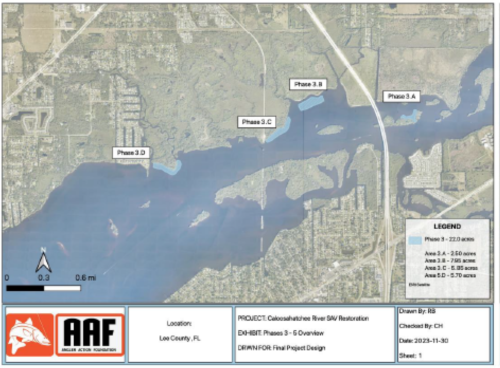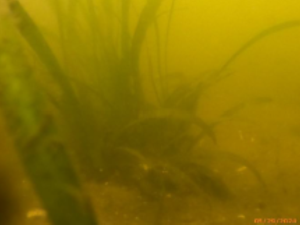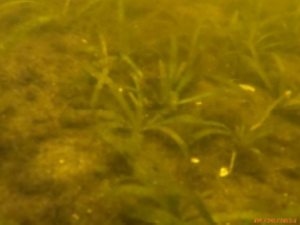“A smooth sea never made a great sailor.”
-Franklin D. Roosevelt
 The Angler Action Foundation (AAF), with partners Sea & Shoreline and Ceilly Aquatic Science & Ecology (CASE), continues to forge ahead with the tape grass restoration project in the Caloosahatchee River. The current active phases of the project include 1,078 ‘herbivory exclusion’ devices and over 100,000 Vallisneria (tape grass) plantings across dozens of acres in the river. The locations were selected based on a variety of factors to increase the likelihood of success, including depth, soil composition, salinity, wave energy and other key points.
The Angler Action Foundation (AAF), with partners Sea & Shoreline and Ceilly Aquatic Science & Ecology (CASE), continues to forge ahead with the tape grass restoration project in the Caloosahatchee River. The current active phases of the project include 1,078 ‘herbivory exclusion’ devices and over 100,000 Vallisneria (tape grass) plantings across dozens of acres in the river. The locations were selected based on a variety of factors to increase the likelihood of success, including depth, soil composition, salinity, wave energy and other key points.
These phases of the project, 3 & 4, are located between the I75 and Hwy 31 bridges, part of an area that historically had about 2,000 acres of healthy tape grass. That tape grass, referred to as submerged aquatic vegetation (SAV), was once home to several species of birds and ducks, crabs, turtles, baitfish and gamefish such as tarpon, snook and more.
A series of extreme weather events in the 90's, combined with water management practices which made the conditions even worse, caused the die-off of the native grass beds.
Since then, a few groups have tried to restore the grass. Most of them resulted in failed attempts – which has resulted in some folks still doubting the success of this current project.
We’re glad those smaller projects were attempted, as they allowed us to better understand what is needed to build a successful restoration project in the Caloosahatchee River. Even with the advantage of previous efforts to review, we don’t expect smooth waters from start to finish, but there is good reason for optimism.
Thus far, the project is on a trajectory for long-term success.
 One key reason for the difference is the application of the ‘herbivory exclusion devices’, which essentially just keep manatees and other hungry critters from chomping the grass down before it can flower and seed.
One key reason for the difference is the application of the ‘herbivory exclusion devices’, which essentially just keep manatees and other hungry critters from chomping the grass down before it can flower and seed.
Another reason for our current success is the scale of the project. For example, a small pilot project that covers just a few square feet can be wiped out by just a handful of blue crabs passing through in one night. Planting dozens of acres – in very strategic locations along with the protective cages – greatly reduces the chance of one or two stray animals wiping out the project.
The grasses planted in the current phases have been in place for roughly six months. Some plants were installed under the cages, while smaller, single-plug plants were canvassed across the entire project area.
The hope is that the caged plants will be mature enough to remove the cages all at once after about 12 months. By that time, the plants in the cages should be strong enough to withstand grazing.
Each month or two (as needed), biologists gear up and head into the project areas to inspect the health of the plants, take some environmental measurements (salinity, turbidity, water temperatures, etc.) and clean the cages. The work is exhausting but very important.
The cages require aggressive cleaning due to what is called biofouling, or the collection of ‘river gunk’, from the cages themselves. It’s not actually gunk of course, but a collection of filamentous algae, snails, crustaceans, macro algae and anything else that sticks to the cages as water flows down the river. This is an important step, because if the walls of the cages become too cluttered and sunlight is occluded, the plants will die.
The plants in the cages also throw off ‘floaters’, small plant nodes that include leaves and roots. They rise to the top of the cages, which must be scooped from the cages so they don't shade the rooted plants. These floaters are a bonus, as the biologists carefully hand plant each of them in the ground within the project areas.
 The most recent maintenance event was completed at the end of May. Plants in the cages are doing what we hoped – thriving and growing. Grass blades have grown to a range of 30-90 cm long, with grass already poking through the top of some of the cages. Any cages that are found empty are replanted, usually with the floaters from nearby cages. Importantly, many cages are showing signs of plants expanding outside the cages (see the image to the right, with the little plants along the base rim of the cage).
The most recent maintenance event was completed at the end of May. Plants in the cages are doing what we hoped – thriving and growing. Grass blades have grown to a range of 30-90 cm long, with grass already poking through the top of some of the cages. Any cages that are found empty are replanted, usually with the floaters from nearby cages. Importantly, many cages are showing signs of plants expanding outside the cages (see the image to the right, with the little plants along the base rim of the cage).
The plants outside of the cages are hanging in there, with a survival rate better than 50% overall and some spreading of plants to boot. This all suggests we're on pace to accomplish our goal, which is to see the entire area restored with healthy tape grass meadows.
The project has been funded by Florida’s DEP via appropriations. This means that local politicians have played a massive role in the current success we are seeing with the project. Governor Desantis also had a pivotal role, as he reviewed and approved each phase of the project.
 AAF is very close to securing the necessary permits to begin planting in Phase 5, which includes more strategic locations within the immediate region. The current success has generated enough optimism to allow an additional $3.5 million from the current budget (approved by Gov. Desantis just last week).
AAF is very close to securing the necessary permits to begin planting in Phase 5, which includes more strategic locations within the immediate region. The current success has generated enough optimism to allow an additional $3.5 million from the current budget (approved by Gov. Desantis just last week).
AAF Board member Pete Quasius, who lived on this very stretch of river and guided fly fishing trips with his wife Maria back when there was a thriving tarpon population, is very excited about the success thus far. “There used to be schools of thousands of ducks feeding in the grass beds, and tarpon rolling all through the area. It has been a desert for decades, but now there is justified hope that we’re going to finally turn things back around,” he said during a recent visit to the area.
Maintenance and monitoring will continue in areas 3 and 4 for a total of three years. Future phases will expand the footprint and further increase the chances of success.
One critical point of note is the pending completion of the C43 resevoir - scheduled to become operational in the spring of 2025 - which will provide a more consistent flow of fresh water down the river, moving flow rates closer to historical patterns. It’s quite possible that had the C43 project – a part of the massive overall federal Everglades Restoration work – had been in place in the early 90s, the historical grass beds would have survived. Regardless, the improved water flow should greatly increase the expectations of long-term success for the current project.
What can you do to help? First you can reach out to the local state politicians who supported this project and thank them. Sen Passidomo in particular has been a supporter of the project since we started putting it together back in 2017. The more recent funding was supported directly by Sen. Martin and House Rep. Esposito.
If you are in the area, check out the locations. Be mindful of the cages placed throughout – they are metal mesh and loosely anchored to the ground. Thus far, only one of the 1000+ cages currently in the water has been damaged, so keep an eye out and avoid drifting directly over them.
Questions? Reach out to Brett Fitzgerald at brett@angleractionfoundation.org.
